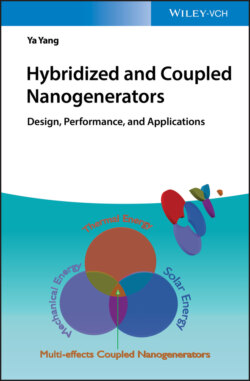Читать книгу Hybridized and Coupled Nanogenerators - Ya Yang - Страница 32
2.3.2.1 Cellulose
ОглавлениеCellulose nanomaterials have many outstanding advantages including high surface area, light weight, and excellent mechanical properties, resulting in an important role in diverse applications [43–47]. Plant cell walls have a great deal of cellulose, a fibrous water‐loving polymer, which is generated through the plant cellular growth process and cellulose biogenesis. Some creatures, such as fungi, invertebrates, and algae, also have cellulose. The entire process for forming cellulose needs van der Waals force and hydrogen bonds. There are two parts (crystalline and amorphous parts) in cellulose fibrils. CNCs can be generated by insulating crystalline domains, and cellulose nanofibrils (CNFs) can be produced through mechanical interventions. Both of them are nanoscale lateral dimensions, which can realize many outstanding advantages, including low density, flexibility, and large aspect ratio [48–50].
Chen et al. developed a transparent TENG, where CNCs were used as the positive triboelectric materials because of their prominent excellent mechanical properties and nano‐sized slender structures [51]. CNCs in the bleached kraft pulp can be produced by acid hydrolysis method. Figure 2.6b shows the prepared CNCs suspension with high transparency. An ITO film was fixed on a PET substrate, and the suspension was dropped on the film as shown in Figure 2.6a. After the water was evaporated at room temperature, the CNC film could completely cover the ITO film. The prepared CNC/ITO film possesses great transparency, as illustrated in Figure 2.6c. Transmission electron microscopy (TEM) images of the CNCs show the scale of the prepared CNCs, with 50–300 nm length and 3–5 nm width (Figure 2.6d). Figure 2.6e shows the atomic force microscopy (AFM) image of the ITO film. The AFM image of CNC/ITO presents high surface roughness. When the surface of the CNC film makes contact with the FEP film under the external force, the electrons could flow from the CNC film to the surface of the FEP film because the CNC film holds a positive position in the triboelectric series.
Figure 2.6 The CNCs/ITO film. (a) The schematic for preparing the CNCs/ITO films. (b) Photograph of the CNCs suspension. (c) The prepared CNCs/ITO electrode. (d) TEM image of the prepared CNCs. (e) AFM image of the ITO substrate. (f) AFM image of the CNCs/ITO substrate.
Source: Reproduced with permission from Chen [51]. Copyright 2018, Elsevier.
Bacterial cellulose (BC) has been widely used due to outstanding advantages such as high elastic modulus, good degree of polymerization, and biocompatibility. Kim et al. used bacterial nanocellulose film as the triboelectric material in the TENG. The bacteria can generate the BC pellicle in a gel state. The uniform BC film was prepared by dissolving the BC pellicle at a specified concentration [52]. CNFs generated from nanosized cellulose fibrils are proverbially used in modern electronic devices due to their desirable surface roughness and electrical properties. Yao et al. produced biodegradable CNF films with nanostructured surface and applied them in the TENG [53]. The CNF hydrogel was produced into a CNF film by a treating process, where wood pulp was oxidized and then mechanically homogenized. By filtering and the drying processes, the CNF hydrogel can be transformed to transparent and flexible CNF thin films. When contacted with the FEP film, the surface of the CNF film could hold positive triboelectric charges due to its very positive position on the triboelectric series. Single cellulose films are fragile and volatile. To conquer these problems, Chandrasekhar et al. developed a cellulose/polydimethylsiloxane (PDMS) film in the TENG [54]. Composite films with irregular surface roughness were fabricated by solidifying the mixed solution of cellulose powders and PDMS on the sandpaper template. The content of cellulose could affect the output performance of the TENG. Peng et al. fabricated the composite film with PDMS and CNC flakes and found that the cellulose can increase the output performance of the TENG due to the favorable dielectric property [55].
One drawback of natural CNFs is the weak polarization, resulting in low capability to generate surface charges. Introducing different chemical groups to the CNFs could increase the capability. Yao et al. fabricated the CNF film by filtering the hydrogel and then drying, and modified the film by a nitration acid mixture of HNO3, H2SO4, and water [56]. Compared to the pristine CNFs in the corresponding Fourier transform infrared spectroscopy (FTIR) curves, the nitro‐CNFs possessed three new intense peaks due to asymmetric and symmetric stretching of the NO2 group and stretching of the NO bonds. The output voltage signals of the pristine CNF–Cu pair were about 0.8 V and of the nitro‐CNF–Cu pair were about 4.9 V, in the TENGs. Nanostructures on triboelectric materials can increase contacting areas, leading to increased electrostatic charges on these surfaces. Šutka et al. developed highly porous ethyl cellulose (EC) nanostructured films for the TENG [57]. The porous EC films were fabricated by phase inversion of the mixed solution (ethyl cellulose, ethanol, and toluene). The output voltage signals of the TENG based on porous EC films are higher than that of the TENG based on primary EC films. He et al. developed 1D cellulose nanofibers into the pores of cellulose microfibers skeleton, leading to the fabrication of a nanostructured paper, which can be used as template to carry other materials [58].
To boost the electron‐donating tendency of cellulose, Oh et al. fabricated highly conductive ferroelectric cellulose composite papers, which consist of cellulose, silver nanowires, and BaTiO3 nanoparticles [59]. The composite papers were produced through a simple filtration method, with the thickness of the prepared paper of about 70 μm, and were used in the TENG, resulting in high output performances. With the rapid development of printing technique, some researchers explored new methods to fabricate surfaces with micro/nanostructure. Qian et al. developed a biocompatible cellulose‐based TENG through the all‐printing method. The 3D patterned positive layer could be fabricated by printing the CNF ink onto the Ag/PET substrates [60].
